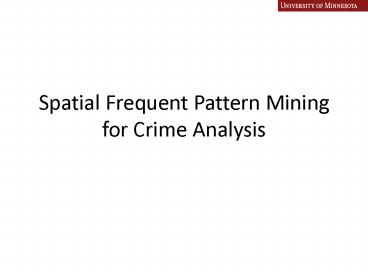Spatial Frequent Pattern Mining for Crime Analysis PowerPoint PPT Presentation
Title: Spatial Frequent Pattern Mining for Crime Analysis
1
Spatial Frequent Pattern Mining for Crime Analysis
2
Application Questions
- Crime analysis
- Localizing frequent crime patterns,
Opportunities for crime vary across space!
Question Do downtown bars often lead to
assaults more frequently ?
- Law enforcement planning
Question Where are the frequent crime routes ?
- Courtsey www.startribune.com
Forecasting crime levels in different
neighborhoods.
- Predictive policing (e.g. forecast crime levels
in different neighborhoods )
Question What are the crime levels 1 hour after
a football game within a radius of 1 mile ?
3
Scientific Domain Environmental Criminology
Routine activity theory and Crime Triangle
Crime pattern theory
Courtsey http//www.popcenter.org/learning/60step
s/index.cfm?stepnum8
Courtsey www.amazon.com
Courtsey http//www.popcenter.org/learning/60step
s/index.cfm?stepNum16
- Crime Event Motivated offender, vulnerable
victim (available at an appropriate location and
time), absence of a capable guardian.
- Crime Generators offenders and targets come
together in time place, large gatherings (e.g.
Bars, Football games)
- Crime Attractors places offering many
criminal opportunities and offenders may relocate
to these areas (e.g. drug areas)
6
4
Spatial Frequent Pattern Mining
Process of discovering interesting, useful and
non-trivial patterns from spatial data.
5
Illustrative Frequent Patterns Regional
Co-location
- Input Spatial Features, Crime Reports.
- Output RCP (e.g. lt (Bar, Assaults), Downtown gt)
- Subsets of spatial features / Crime Types.
- Frequently located in certain regions of a study
area.
Larceny, Bars and Assaults
Q. Are downtown Bars likely to be more crime
prone than others ?
Dataset Lincoln, NE, Crime data (Winter 07),
Neighborhood Size 0.25 miles, Prevalence
Threshold 0.07
Observation Bars in Downtown are more likely to
be crime prone than bars in other areas (e.g.
20.1 Shown by blue polygon area).
N
6
Illustrative Frequent Patterns K Main Routes
- Input Crime Reports, Road Network, K ( of
Patrol Vehicles) - Output K- Main Routes Taken by the Patrol
Vehicles
Dataset U.S. City (Southern U.S), K 10
N
K- Main Routes / CrimeStat ellipses
K- Main Routes
7
Illustrative Frequent Patterns Crime Outbreaks
- Input Crime Reports, Crime Types, Spatial
Features (Bars) - Output (a) Bars with more than usual crime
activity, (b) Crime Types that are highly active
around bars, (c) Regions (Crime Outbreaks)
around Bars with high risk of crime.
N
Vandalism Crime Outbreaks around Bars.
Alcohol crime outbreaks around bars.
Legend (a) Risk Region Represented by Red
Circle (b) Black stars () represent Bars
8
Number of Crime Outbreaks By Crime Type,
Lincoln 2007
9
Crime Outbreaks to Regional Crime Patterns
- Input Crime types involved in a large number of
significant Crime Outbreaks (Slide 7s output) - Output Regional co-location patterns between
crime types involved in one or more outbreaks.
Dataset Lincoln, NE, Crime data (2007),
Neighborhood Size 700 feet, Prevalence
Threshold 0.001
Observation Bars in Downtown have a marginally
higher chance (4.6) to witness Alcohol as well
as Vandalism related Crime Outbreaks (Center
Polygon).
10
Spatio-temporal Frequent patterns Cascading
Patterns
N
11
Lincoln, NE crime dataset Case study
- Is bar closing a generator for crime related
CSTP ?
N
Bar locations in Lincoln, NE
Questions
- Does Crime Peak around bar closing ?
- Observation Crime peaks around bar-closing!
12
References
- S. Shekar, P.Mohan, D.Oliver, X. Zhou. Crime
Pattern Analysis A spatial frequent pattern
mining approach. Department of Computer Science
and Engineering, University of Minnesota,
Twin-Cities, Tech Report (TR 12-015), URL
http//www.cs.umn.edu/tech_reports_upload/tr2012/1
2-015.pdf - P.Mohan, S.Shekhar, J.A. Shine, J.P. Rogers,
Z.Jiang, N. Wayant. A spatial neighborhood graph
approach to Regional Colocation Pattern
Discovery. - D. Oliver, A. Bannur, J.M. Kang, S.Shekhar, R.
Bousselaire. A K-Main Routes Approach to Spatial
Network Activity Summarization. ICDM Workshops
2010 265-272 - P. Mohan, S. Shekhar, J.A. Shine, J.P. Rogers.
Cascading Spatio-temporal Pattern Discovery. In
IEEE Transactions on Knowledge and Data
Engineering, 2012, November (to Appear). - Jung I,Kulldorff M,Richard OJ,. A spatial scan
statistic for multinomial data . Stat Med. 2010
Aug 15181910-1918
12

